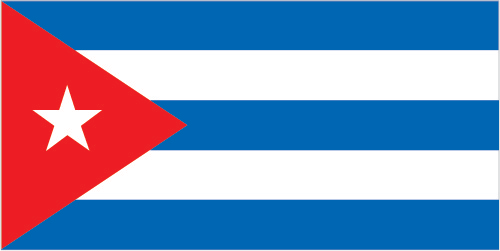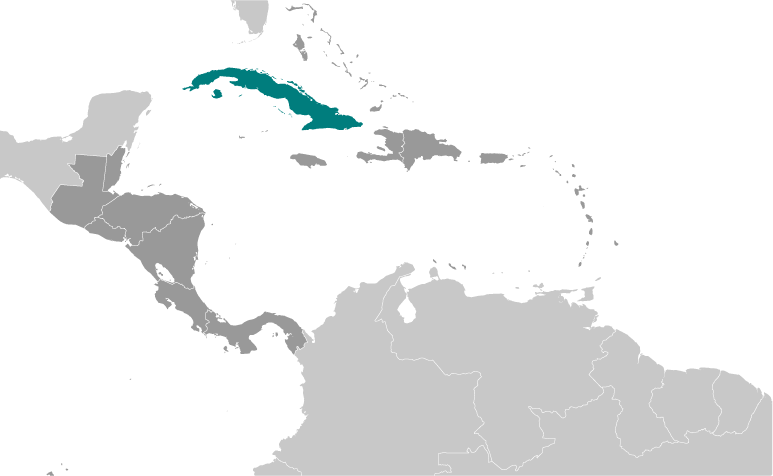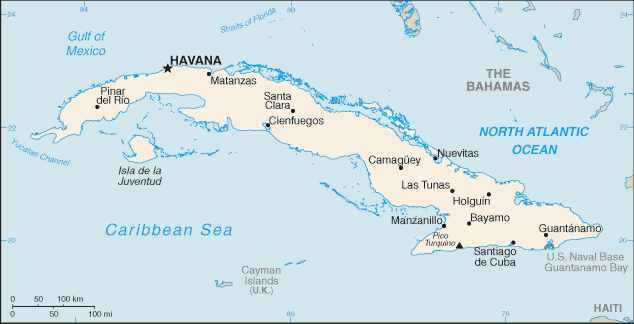|
Country name:
|

|
|
conventional long form: Republic of Cuba
conventional short form:
Cuba
local long form:
Republica de Cuba
local short form:
Cuba
|
|
|
Government type:
|

|
|
Communist state
|
|
|
Capital:
|

|
|
name: Havana
geographic coordinates:
23 07 N, 82 21 W
time difference:
UTC-5 (same time as Washington, DC during Standard Time)
daylight saving time:
+1hr, begins third Sunday in March; ends last Sunday in October; note - Cuba has been known to alter the schedule of DST on short notice in an attempt to conserve electricity for lighting
|
|
|
Administrative divisions:
|

|
|
15 provinces (provincias, singular - provincia) and 1 special municipality* (municipio especial); Artemisa, Camaguey, Ciego de Avila, Cienfuegos, Granma, Guantanamo, Holguin, Isla de la Juventud*, La Habana, Las Tunas, Matanzas, Mayabeque, Pinar del Rio, Sancti Spiritus, Santiago de Cuba, Villa Clara
|
|
|
Independence:
|

|
|
20 May 1902 (from Spain 10 December 1898; administered by the US from 1898 to 1902); not acknowledged by the Cuban Government as a day of independence
|
|
|
National holiday:
|

|
|
Triumph of the Revolution, 1 January (1959)
|
|
|
Constitution:
|

|
|
24 February 1976; amended July 1992 and June 2002
|
|
|
Legal system:
|

|
|
civil law system based on Spanish civil code
|
|
|
International law organization participation:
|

|
|
has not submitted an ICJ jurisdiction declaration; non-party state to the ICCt
|
|
|
Suffrage:
|

|
|
16 years of age; universal
|
|
|
Executive branch:
|

|
|
chief of state: President of the Council of State and President of the Council of Ministers Gen. Raul CASTRO Ruz (president since 24 February 2008); First Vice President of the Council of State and First Vice President of the Council of Ministers Miguel DIAZ-CANEL Bermudez (since 24 February 2013); note - the president is both the chief of state and head of government
head of government:
President of the Council of State and President of the Council of Ministers Gen. Raul CASTRO Ruz (president since 24 February 2008); First Vice President of the Council of State and First Vice President of the Council of Ministers Miguel DIAZ-CANEL Bermudez (since 24 February 2013)
cabinet:
Council of Ministers proposed by the president of the Council of State and appointed by the National Assembly or the 28-member Council of State, elected by the assembly to act on its behalf when it is not in session
(For more information visit the World Leaders website  ) )
elections:
president and vice presidents elected by the National Assembly for a five-year term; election last held on 24 February 2013 (next to be held in 2018)
election results:
Gen. Raul CASTRO Ruz reelected president; percent of legislative vote - 100%; Miguel DIAZ-CANEL Bermudez elected vice president; percent of legislative vote - 100%
|
|
|
Legislative branch:
|

|
|
unicameral National Assembly of People's Power or Asemblea Nacional del Poder Popular (number of seats in the National Assembly is based on population; 614 seats; members elected directly from slates approved by special candidacy commissions to serve five-year terms)
elections:
last held on 3 February 2013 (next to be held in 2018)
election results:
Cuba's Communist Party is the only legal party, and officially sanctioned candidates run unopposed
|
|
|
Judicial branch:
|

|
|
People's Supreme Court or Tribunal Supremo Popular (president, vice presidents, and other judges are elected by the National Assembly)
|
|
|
Political parties and leaders:
|

|
|
Cuban Communist Party or PCC [Raul CASTRO Ruz, first secretary]
|
|
|
Political pressure groups and leaders:
|

|
|
Human Rights Watch; National Association of Small Farmers
|
|
|
International organization participation:
|

|
|
ACP, ALBA, AOSIS, CELAC, FAO, G-77, IAEA, ICAO, ICC (national committees), ICRM, IFAD, IFRCS, IHO, ILO, IMO, IMSO, Interpol, IOC, IOM (observer), IPU, ISO, ITSO, ITU, LAES, LAIA, NAM, OAS (excluded from formal participation since 1962), OPANAL, OPCW, PCA, Petrocaribe, UN, UNCTAD, UNESCO, UNIDO, Union Latina, UNWTO, UPU, WCO, WFTU (NGOs), WHO, WIPO, WMO, WTO
|
|
|
Diplomatic representation in the US:
|

|
|
none; note - Cuba has an Interests Section in the Swiss Embassy, headed by Principal Officer Jorge BOLANOS Suarez; address: Cuban Interests Section, Swiss Embassy, 2630 16th Street NW, Washington, DC 20009; telephone: [1] (202) 797-8518; FAX: [1] (202) 797-8521
|
|
|
Diplomatic representation from the US:
|

|
|
none; note - the US has an Interests Section in the Swiss Embassy, headed by Chief of Mission John P. CAULFIELD; address: USINT, Swiss Embassy, Calzada between L and M Streets, Vedado, Havana; telephone: [53] (7) 839-4100; FAX: [53] (7) 839-4247; protecting power in Cuba is Switzerland
|
|
|
Flag description:
|

|
|
five equal horizontal bands of blue (top, center, and bottom) alternating with white; a red equilateral triangle based on the hoist side bears a white, five-pointed star in the center; the blue bands refer to the three old divisions of the island: central, occidental, and oriental; the white bands describe the purity of the independence ideal; the triangle symbolizes liberty, equality, and fraternity, while the red color stands for the blood shed in the independence struggle; the white star, called La Estrella Solitaria (the Lone Star) lights the way to freedom and was taken from the flag of Texas
note:
design similar to the Puerto Rican flag, with the colors of the bands and triangle reversed
|
|
|
National anthem:
|

|
|
name: "La Bayamesa" (The Bayamo Song)
lyrics/music:
Pedro FIGUEREDO
note:
adopted 1940; Pedro FIGUEREDO first performed "La Bayamesa" in 1868 during the Ten Years War against the Spanish; a leading figure in the uprising, FIGUEREDO was captured in 1870 and executed by a firing squad; just prior to the fusillade he is reputed to have shouted, "Morir por la Patria es vivir" (To die for the country is to live), a line from the anthem
|
|
|
|
|





 )
)



